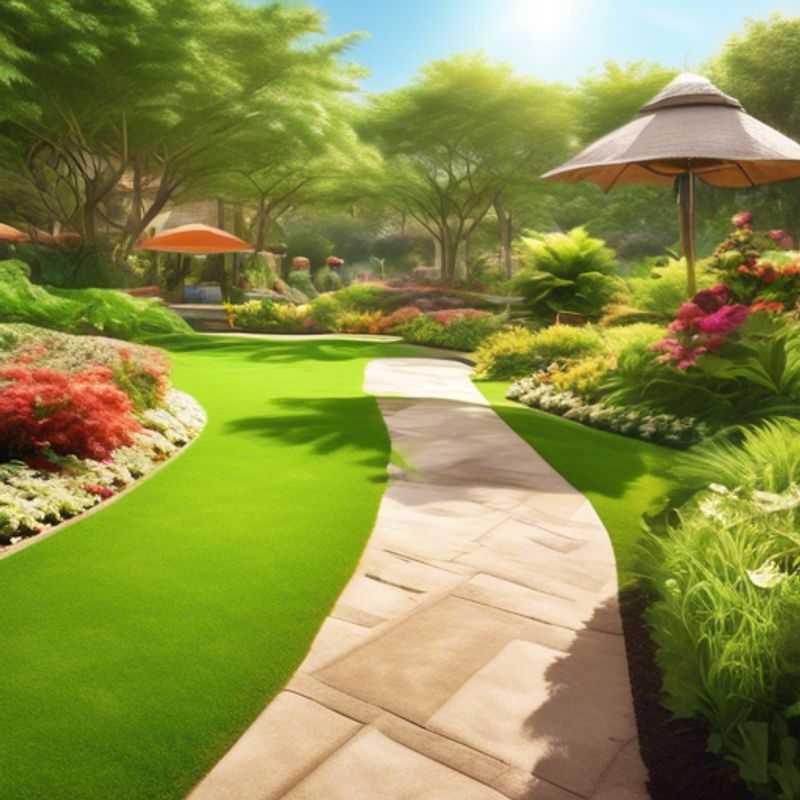Top Things to Know Before Buying Lawn & Garden Supplies: A Beginner's Guide

Top Things to Know Before Buying Lawn & Garden: Measure Your Space, Research Your Needs, Consider Climate and Soil, Plan Your Layout, Invest in Quality Tools, Understand Maintenance, Familiarize Yourself with Regulations
Getting your lawn and garden looking great is a rewarding project. But before you head to the store and start buying everything in sight, there are a few key things to consider. It’s a bit like planning a building project – you wouldn’t start constructing without a plan, would you? So, let's get those green thumbs ready and dive into the essential steps to prepare for lawn and garden success!
First things first, measure the area of your lawn or garden. This will help you determine the amount of grass seed, soil, mulch, and other supplies you’ll need. You don’t want to end up with too little or too much of anything, right?
Next, research different types of grass, plants, and gardening tools. Not all grasses are created equal, and some plants thrive in different climates. Think about the look you want to achieve, your local weather conditions, and how much time you're willing to dedicate to upkeep.
Consider the climate and soil conditions in your area when selecting plants. You want to choose plants that will flourish in your environment. A chat with your local garden center or a quick online search can provide valuable information about what grows well in your region.
Create a plan for your lawn and garden layout to maximize space and aesthetics. Think about where you want to place trees, shrubs, flowers, and paths. This will help you create a visually appealing and functional space.
Invest in quality gardening tools and equipment to make the work easier and more enjoyable.

Measure Your Lawn or Garden: Calculating Supplies Made Easy
Knowing the area of your lawn or garden is crucial for purchasing the right amount of supplies, such as fertilizer, grass seed, or mulch. Here's a simple guide to help you measure your outdoor space:
1. Divide and Conquer: Break down your lawn or garden into smaller, simpler shapes like rectangles, squares, triangles, or circles. This will make calculating the area easier.
2. Measure and Record: Use a measuring tape to determine the length and width of each section. Record your measurements accurately.
3. Calculate Areas:
Rectangle or Square: Area = Length x Width.
Triangle: Area = (1/2) x Base x Height.
Circle: Area = π x Radius2 (where π is approximately 3.14).
4. Add It Up: Sum the areas of all the individual shapes to get the total area of your lawn or garden.
Tips:
- You can use online calculators or apps for easy area calculations.
- If your lawn or garden has irregular shapes, you can estimate the area by breaking it into smaller, more regular shapes and approximating the area.
- Remember to convert all measurements to the same units (feet, meters, etc.) before calculating the area.
By following these steps, you can accurately measure your lawn or garden and purchase the right amount of supplies to keep it healthy and beautiful.

From Seed to Success: Choosing the Right Grass, Plants, and Tools for Your Garden
When embarking on a landscaping project, it’s crucial to meticulously research the types of grass, plants, and gardening tools that align with your specific requirements.
First, consider the climate where you reside. Some grasses thrive in hot, dry climates, while others excel in cool, humid environments. If you want to attract pollinators and add color, choose a diverse array of plants. Research the types of plants that are compatible with your soil type and sunlight levels.
Next, evaluate the type of tools you will need to accomplish your goals. If you’re looking for a low-maintenance lawn, a robotic mower might be the perfect solution. If you have a large garden, a tiller or cultivator might be necessary to prepare the soil.
Remember, planning is key. Before purchasing any tools, carefully assess your needs. For instance, a weed trimmer can prove more efficient than a gas-powered mower for edging and trimming. Finally, consider purchasing high-quality tools for longevity and efficiency.

Choosing the Right Plants: Climate and Soil First
Choosing the right plants for your garden is key to success. Knowing your climate and soil conditions is crucial for selecting plants that thrive in your area.
Climate refers to the average weather patterns of a region. This includes things like temperature, rainfall, and sunlight. Soil is the foundation for your plants. It influences how well they grow and how much water and nutrients they can absorb.
Understanding your local climate helps you choose plants that can tolerate the hot and cold temperatures, the amount of rain, and the sunlight hours you experience. Soil testing can help you identify the type of soil in your garden, which can then help you select plants that prefer those conditions.
By considering your climate and soil, you can significantly increase the chance of your plants thriving and save you time and money in the long run. Remember, a little research goes a long way in creating a beautiful and sustainable garden.

Maximize Your Outdoor Space: Planning the Perfect Lawn and Garden Layout
Designing your lawn and garden layout is like crafting a beautiful outdoor masterpiece. It's about maximizing space, ensuring functionality, and reflecting your unique style. But don't worry, it doesn't have to be overwhelming! Here's a simple guide to help you create a plan that's both practical and aesthetically pleasing.
First, measure your space. This includes your lawn area, any existing structures like patios, and even things like trees and shrubs. Knowing your exact dimensions is key for drawing a precise plan. This might require a measuring tape or laser distance meter, depending on your space.
Next, consider your needs. What activities do you want to enjoy in your outdoor space? Do you envision a vegetable garden, a cozy seating area, or maybe even a play space for kids? Knowing your desires will help you decide how to best utilize your area.
Now, start sketching! You can use graph paper or a simple drawing app on your phone. This will help you visualize how you want to arrange different elements, like plants, walkways, and seating areas. Don't be afraid to experiment with different configurations!
When arranging your garden, consider sun and shade. Some plants thrive in full sun, while others need partial shade. Take note of where the sun hits your yard throughout the day, and choose plants accordingly. You might need to look up sun requirements for your specific plants if you aren't already familiar with them.
Don't forget about walkways and pathways! They provide easy access to different areas of your garden and enhance its overall layout. Consider materials like gravel, stone, or pavers to add visual interest and define different zones.
Finally, it's time to bring your plan to life. You might need to purchase plants, soil, and other materials, depending on your design. If you're not comfortable doing the work yourself, consider hiring a landscape professional. They can help with everything from planting to creating the perfect features for your outdoor space.

Invest in Quality Gardening Tools: Making Your Green Thumb Happy
Investing in quality gardening tools and equipment is a smart move for any gardener, no matter your experience level. High-quality tools will last longer, work better, and ultimately make your gardening tasks easier and more enjoyable. Think of it as an investment in your gardening success and enjoyment.
Here's why investing in quality is key:
Durability: Well-made tools are built to last. They won't break easily, saving you money on replacements in the long run.
Performance: Quality tools are designed for efficiency. They'll make your work quicker, easier, and more enjoyable. Sharp blades, comfortable handles, and proper weight distribution all contribute to a better gardening experience.
Ergonomics: Good tools are designed with comfort in mind, reducing the risk of strain or injury. This is particularly important for tasks requiring repetitive motions or sustained effort.
While investing in quality tools can be a worthwhile expenditure, it's essential to prioritize your needs and set a budget. Consider these factors:
Start with the Basics: Focus on essential tools like a good trowel, hand cultivator, pruning shears, and a watering can.
Consider your Gardening Style: If you're a vegetable gardener, you might prioritize tools like a hoe and a hand rake. If you enjoy flowers, consider investing in a pair of long-handled pruning shears and a garden trowel.
Research and Compare: Take the time to research different brands and models to find the best value for your money. Read online reviews and check out local garden centers for recommendations.
Investing in quality tools is an investment in your gardening enjoyment. By choosing tools that are durable, efficient, and comfortable to use, you'll be setting yourself up for success in your garden for years to come.

Green Thumbs Up: Understanding Plant and Grass Maintenance
Choosing the right plants and grass for your garden is only half the battle. Understanding their maintenance requirements is crucial to ensure their health and your enjoyment. Here's a quick guide to help you get started:
Water: Different plants have different water needs. Some thrive in dry conditions, while others require consistent moisture. Check the plant tag or online resources to determine how often your chosen plants need watering. Watering deeply but less frequently is better for plant health than shallow, frequent watering.
Light: Plants need adequate sunlight to thrive. Know your plants' light requirements. Will they grow best in full sun, partial shade, or full shade? Don't forget to consider how your garden's light conditions might change throughout the year.
Fertilization: Most plants benefit from fertilization, but the type and frequency will vary. Check the plant tag for specific recommendations. Over-fertilizing can be harmful, so it's essential to follow the instructions carefully.
Pruning: Pruning helps maintain plant shape and encourage healthy growth. Learn the proper pruning techniques for each plant. Some plants need regular pruning, while others may only require occasional maintenance.
Pest and Disease Control: Be vigilant about identifying and treating any signs of pests or diseases early on. Regularly inspect your plants for any unusual changes in their appearance or growth patterns. If you suspect a problem, consult a gardening expert or online resources for diagnosis and treatment options.
Winter Care: Some plants need special winter care, such as mulching, to protect their roots from freezing temperatures. Research the winter care requirements for your plants and take the necessary steps to ensure their survival during the cold months.
Remember, taking the time to understand the maintenance needs of your chosen plants will ensure a healthy and thriving garden for years to come. Enjoy the process of learning and nurturing your green space!

Get to Know Your Local Lawn and Garden Regulations: Permits, Rules, and More
Starting a lawn and garden business? It's essential to understand the local regulations and permits that apply. Failing to comply can lead to fines and even business closure.
First, check with your local municipality or county government for specific requirements. These vary widely based on location, so a general guide won't be sufficient. Common permits include:
Business licenses: This allows you to operate legally within your jurisdiction. You'll need to pay a fee and provide basic business information.
Zoning permits: If you're working on residential properties, zoning regulations might dictate what types of services you can provide and the hours you can operate.
Waste disposal permits: If you're handling yard waste, you'll likely need to adhere to local disposal regulations, which may involve permits and fees.
Contractor licensing: Depending on the scope of your work, you might need to obtain a contractor license. This often requires meeting specific experience and education requirements.
Insurance: You'll need to obtain general liability insurance and potentially workers' compensation insurance to protect yourself and your clients from financial risks.
Once you understand the requirements, you can factor them into your business plan and cost estimates. These are essential for staying compliant and operating your lawn and garden business successfully.
